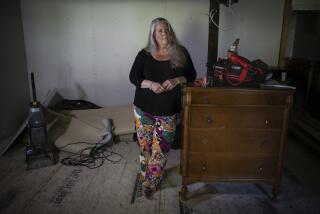Flood-Stricken Regions of Midwest Are Being Deluged With Volunteers : Relief: No job appears to be too small for those trying to help out. Some areas have to cope with too much of a good thing.
QUINCY, Ill. — Nothing is out of the question in Quincy these days.
A woman in nearby Hull needed to evacuate her chickens from a flood plain, so she telephoned the local radio station. The chickens are now high and dry. Excess ground seepage at the levee? Someone will be right along with a semitrailer stuffed with bales of straw. So many sheets of baked brownies are floating around that the Salvation Army is respectfully turning them away.
The main bridge over the Mississippi River is out, the area’s three remaining levees are endangered, but for Quincy’s legion of flood volunteers, no job is too small.
Across the flood-ravaged upper Midwest, big river cities and modest grain elevator towns are astir in an orgy of goodwill. Each day, phone lines at levee commissions, charity organizations and small-town media outlets are tied up by callers ready to house flood victims, willing to shore up crumbling river walls and able to donate sandbags, flatboats, foot powder, anything for the cause.
Yet as Midwesterners pitch in, they sometimes expose tensions that lay hidden beneath their proper sense of civility.
In Quincy and its rural surroundings, residents are veering between acts of selfless charity and petty feuds.
“Helping our neighbors is in our blood, it’s the spirit of the Midwest,” said Leo Henning, general manager of WGEM-AM, a hotel-front radio station that has been Quincy’s lifeline over the past two weeks. “In the old days, people helped build each other’s farms and baled each other’s hay. But a stressful time like this brings out the best and worst in people. We’ve had to deal with all of it.”
In Quincy, a river town of 40,000 people that was once Illinois’ second-largest city until the railroads killed off the steamboat trade in the 1880s, volunteer efforts have always mushroomed after severe floods.
After the great deluge of 1973, Henning recalled, “people pitched in together like we were one big family.”
The largess this time seems bottomless. Tens of thousands of men and women have braved wilting heat and sheets of rain to work at the flood walls. The Red Cross served 280,000 meals in two weeks to flood victims and sandbaggers--all prepared and paid for by residents. On Saturday, local pilots volunteered by the dozens to fly their planes between the Quincy and Hannibal, Mo., airstrips to help residents stranded after the Bayview Bridge was closed by a levee break.
“There’s really no separation between the people who live in town and the people out in the country,” said Phillip Germann, director of the town’s historical society. “I’m sure everyone in town has a relative or friends in many of these little communities. We all want to help.”
In Hull, 15 miles south of Quincy, Helen Friedlein watched as neighbors packed up and fled. Even though the town was nearly deserted, Friedlein’s Railsplitter Motel stayed open for sandbaggers who needed a room. For those volunteers who could afford it, rooms were reduced to $10 a night. Those unable to pay could stay for free.
She also kept her cafe, P.L.’s Place--the P.L., she explained, is for “Pretty Lady”--open as late as 10:30 p.m. each night for hungry National Guard troops and flood workers who just wanted to rest over cups of steaming coffee. “Special rates for flood workers,” read a sign on the door.
“Whatever they can afford, they can pay,” Friedlein said. “They’re working to help me out. The least I can do is return the favor.”
Unable to sandbag or shovel earth, Quincy’s older residents have helped out in their own ways, preparing cold cuts and iced tea or sitting out under the shade of trees, tying off sandbags.
Bob Sturgis, a retiree in his 60s, is shuttling flood workers along the 52-mile long Sny Island Levee in his van.
“You can’t sit around your house all day while everybody’s helping out,” Sturgis said.
His passenger one day last week was Craig Robinson, 24, a diesel mechanic with a darker take on Quincy’s volunteer spirit.
For two weeks, Robinson has sandbagged along the levee. His back aches and his joints are stiff. As he toils at the Sny Island Levee, Robinson says he sometimes wonders whether the farmers who own tracts of land behind the levee will be grateful for the help they are getting from residents like him.
“Whenever you want to go on their property to hunt or whatever, they tell you to get lost,” he muttered in the van. “They damn well better show some appreciation this time.”
In the levee districts, most officials have taken their newfound authority over peoples’ lives in stride. But some levee bosses have turned into flood plain despots, barking orders at volunteers and treating their drainage districts like personal fiefdoms.
Henning said he scolded one levee commissioner for ignoring the needs of 20 low-income trailer camp residents who were worried that their flood wall was about to break.
“These poor people were scared out of their wits, and this guy calls me up and yells at me that they don’t have a problem,” Henning said. “I told him: ‘Sparky, do the right thing and go down there and hold those people’s hands.’ ”
Some volunteers have been so eager to help that they teeter on charity hysteria, snarling relief operations by flailing about in their desperation to give.
“Everybody’s so wonderful,” gushed a farmer’s wife as she eyed a six-foot-long board of food left at the Sny Island Levee command post in New Canton, Ill., 20 miles south of Quincy.
Relief operations were going on elsewhere, but the farmer’s wife would not leave, determined that New Canton was the place where she was needed.
“I think almost everyone in this town is well-intentioned,” said a levee official. “The problem is they’re not always focused on the matters at hand.”
WGEM’s broadcasters said they realized they would have to deal equally with Quincy’s best and worst impulses.
The station has been so vital a cog in the town’s volunteer operations that its staff was commended for its performance by President Clinton in an on-air call Saturday from Air Force One. But Henning ordered his on-air workers from the start to deal toughly with angry callers--no matter who they were.
“We decided to jump on them,” Henning said. “We tell them: ‘You made your point, but now’s not the time to debate it. That way we don’t go off on a thousand tangents. There’s too many fast-moving events to get bogged down in that.”
Callers have complained about being stopped at roadblocks by National Guard troops. One caller griped that she had prepared ham sandwiches all morning, only to be turned down by social service agencies concerned that the food might spoil.
“Haven’t you ever heard of salmonella?” asked one exasperated radio show host.
More to Read
Sign up for Essential California
The most important California stories and recommendations in your inbox every morning.
You may occasionally receive promotional content from the Los Angeles Times.










